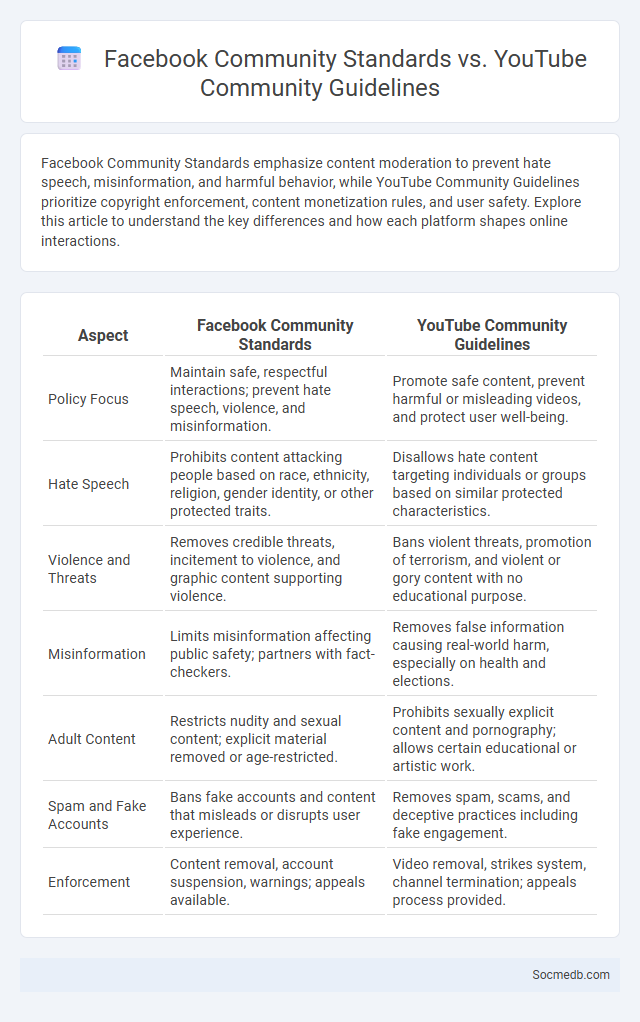
Photo illustration: Facebook Community Standards vs YouTube Community Guidelines
Facebook Community Standards emphasize content moderation to prevent hate speech, misinformation, and harmful behavior, while YouTube Community Guidelines prioritize copyright enforcement, content monetization rules, and user safety. Explore this article to understand the key differences and how each platform shapes online interactions.
Table of Comparison
| Aspect | Facebook Community Standards | YouTube Community Guidelines |
|---|---|---|
| Policy Focus | Maintain safe, respectful interactions; prevent hate speech, violence, and misinformation. | Promote safe content, prevent harmful or misleading videos, and protect user well-being. |
| Hate Speech | Prohibits content attacking people based on race, ethnicity, religion, gender identity, or other protected traits. | Disallows hate content targeting individuals or groups based on similar protected characteristics. |
| Violence and Threats | Removes credible threats, incitement to violence, and graphic content supporting violence. | Bans violent threats, promotion of terrorism, and violent or gory content with no educational purpose. |
| Misinformation | Limits misinformation affecting public safety; partners with fact-checkers. | Removes false information causing real-world harm, especially on health and elections. |
| Adult Content | Restricts nudity and sexual content; explicit material removed or age-restricted. | Prohibits sexually explicit content and pornography; allows certain educational or artistic work. |
| Spam and Fake Accounts | Bans fake accounts and content that misleads or disrupts user experience. | Removes spam, scams, and deceptive practices including fake engagement. |
| Enforcement | Content removal, account suspension, warnings; appeals available. | Video removal, strikes system, channel termination; appeals process provided. |
Introduction to Online Community Standards
Online community standards establish clear guidelines for acceptable behavior, content sharing, and interaction within social media platforms, promoting respectful and safe environments. These standards often include policies on hate speech, misinformation, harassment, and user privacy, ensuring compliance with legal regulations and platform values. Enforcing community standards helps maintain user trust, enhances engagement quality, and protects diverse online communities from harmful actions.
Overview of Facebook Community Standards
Facebook Community Standards outline the platform's rules to maintain a safe and respectful environment for over 3 billion users worldwide. These guidelines address content related to hate speech, violence, harassment, misinformation, and adult content, ensuring user interactions comply with global legal and ethical norms. Enforcement mechanisms include content removal, account suspensions, and appeals processes powered by AI and human reviewers to uphold community integrity.
Key Elements of YouTube Community Guidelines
YouTube Community Guidelines prioritize safety, respect, and compliance to maintain a positive environment for creators and viewers. Key elements include prohibitions on harmful content such as hate speech, harassment, and misinformation, along with rules governing spam and deceptive practices. Understanding these guidelines helps you navigate content creation responsibly while protecting your channel and audience from violations.
Comparing Facebook and YouTube Content Policies
Facebook and YouTube both enforce strict content policies to regulate inappropriate material but differ significantly in focus and scope. Facebook emphasizes community standards targeting hate speech, misinformation, and harassment across personal profiles and pages, whereas YouTube prioritizes copyright protection, monetization guidelines, and video-specific content like misleading metadata. Understanding these policy distinctions helps you tailor your content strategy effectively on each platform.
Enforcement Mechanisms: Facebook vs YouTube
Facebook employs sophisticated enforcement mechanisms using artificial intelligence and human moderators to detect and remove harmful content, ensuring compliance with its community standards. YouTube utilizes automated systems combined with user reporting and manual review processes to enforce its policies, prioritizing the removal of hate speech, misinformation, and copyright violations. You can maximize your content's reach by understanding the distinct enforcement approaches these platforms apply to maintain safe and compliant online environments.
Appeals and Review Processes on Both Platforms
Social media platforms incorporate appeals and review processes to address content disputes and ensure fair user experiences. These systems allow You to challenge content removals or account restrictions, with reviewers evaluating appeals based on community guidelines and policy compliance. Effective appeals processes enhance transparency and trust, crucial for user retention and platform credibility.
Community Guidelines: General Principles and Best Practices
Community guidelines establish standards for respectful and safe interactions on social media platforms, promoting positive user experiences. Key principles include prohibiting hate speech, harassment, misinformation, and harmful content to protect users and foster inclusive environments. Best practices involve regular monitoring, clear enforcement policies, user education, and transparent reporting mechanisms to maintain platform integrity and trust.
Impact on Users: Bans, Strikes, and Content Removal
Social media platforms enforce bans, strikes, and content removal to regulate user behavior and uphold community standards, directly impacting user engagement and freedom of expression. These measures aim to combat misinformation, hate speech, and harmful content, thereby promoting safer online environments but sometimes sparking debates on censorship and digital rights. The consequences of such enforcement include account suspensions or permanent bans, affecting users' social reach and digital presence significantly.
Updates and Transparency in Moderation Policies
Social media platforms frequently update their moderation policies to enhance transparency and build user trust. Clear guidelines regarding content removal and reporting procedures are published regularly to keep communities informed. These updates enable users to better understand enforcement actions and promote accountable digital spaces.
Future Trends in Community Standards for Social Platforms
Emerging future trends in community standards for social platforms emphasize advanced AI-driven content moderation to enhance accuracy and reduce biases. Platforms are increasingly adopting transparent policies and user-centric appeal processes to foster trust and accountability. You can expect stricter enforcement of misinformation controls and greater emphasis on protecting digital well-being across diverse online communities.
 socmedb.com
socmedb.com